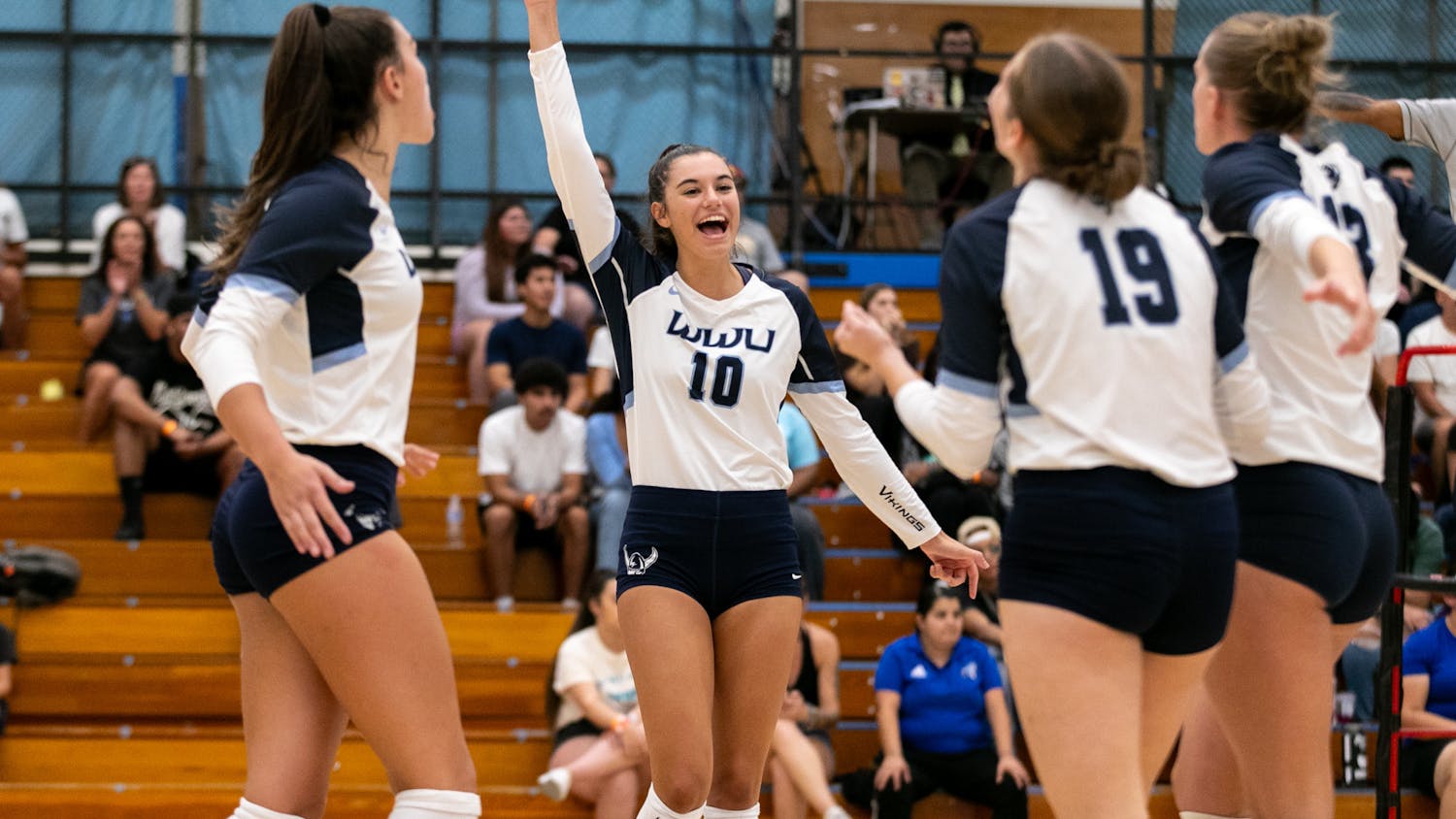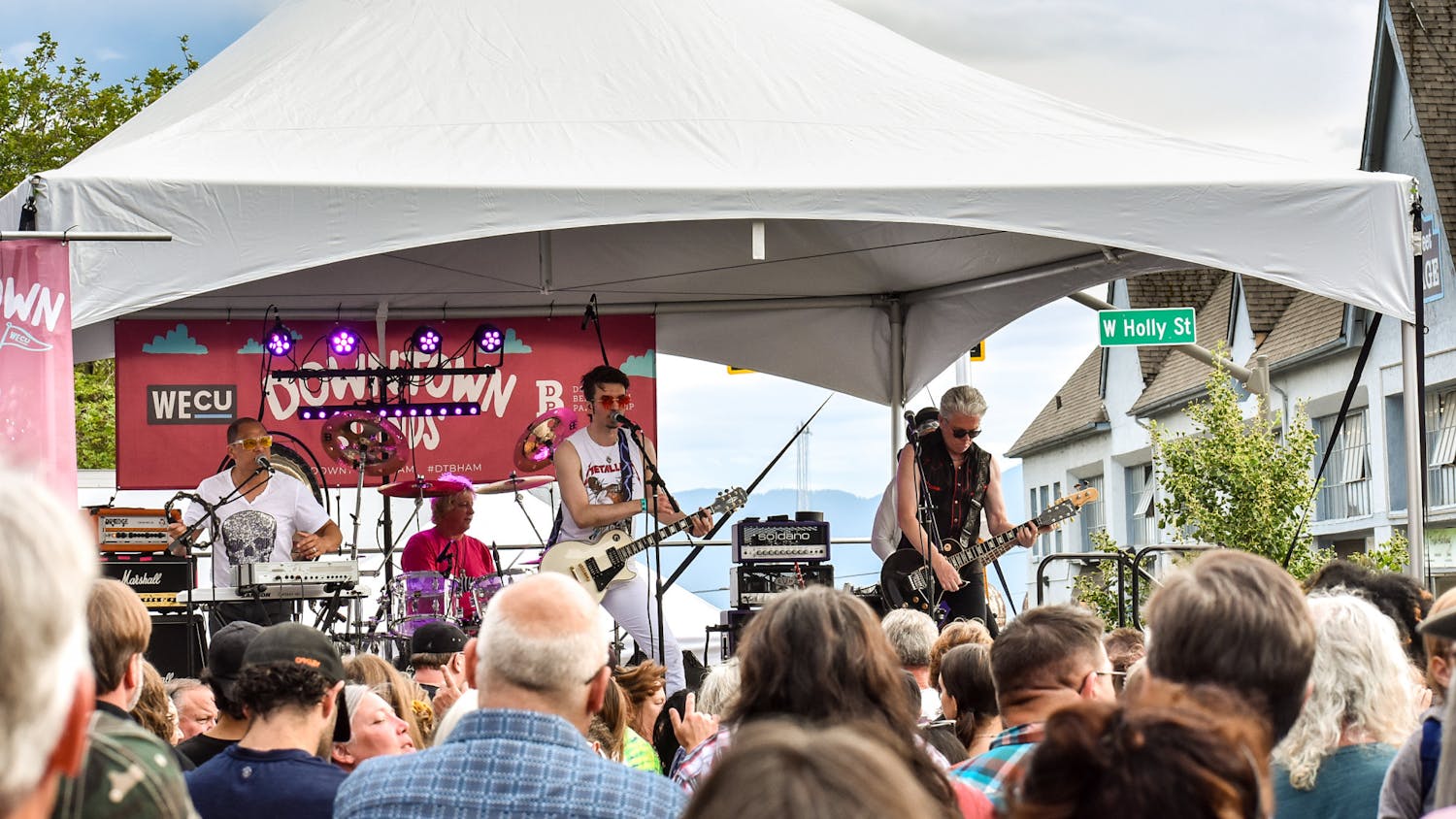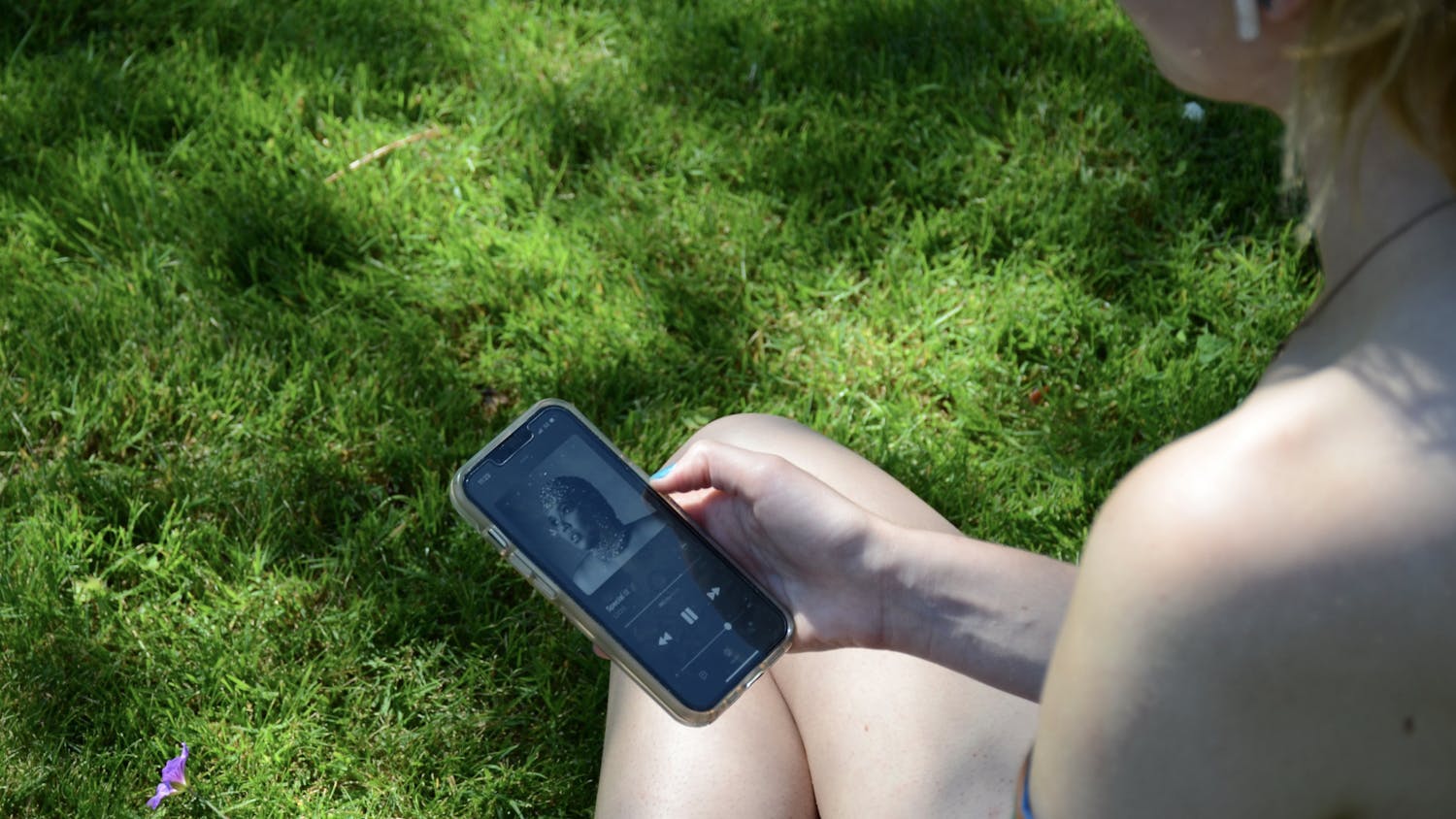A display of handwritten entries on display at the Western Gallery on Monday, Nov. 25. // Photo by Claire Ott
By Elizabeth Hall
Sebastian Mendes has heard his grandfather’s story for his entire life, ever since he was old enough to understand English.
His grandfather was a Portuguese diplomat in Southern France during World War II, and helped refugees passing through the area to avoid the German army, according to the Sousa Mendes Foundation.
Mendes’ grandfather would give the refugees passports and visas to enter Portugal. He assigned 30,000 visas, 10,000 of which were for Jewish people.
“Saving 30,000 people is just incredible,” Western Gallery Director Hathor Yngvason said.
Yngvason said Mendes wanted to honor his grandfather as an artist and work with the story he heard growing up. Mendes started a series of drawings to do so.
The drawings are a compilation of the names of refugees his grandfather saved, Yngvason said. Mendes also started durational performances, where artists perform over days and sometimes weeks, to honor the long hours his grandfather worked until he collapsed from physical exhaustion.
“It wasn’t until my late 20s that I made my first visit to Portugal and that was kind of an epiphany in a way for me really, I think to actually go to the various places that had enriched my memory of what had happened,” Mendes said, according to the Sousa Mendes Foundation.
To represent the repetitiveness of signing so many visas over a short period of time, Mendes created 30 drawings with 1,000 names each, over the course of four years. Each drawing took 10-20 hours to do.
“It gave me a lot of opportunities to actually think constantly about how I felt about my grandfather, which is really something so deeply personal to me,” Mendes said, according to the Sousa Mendes Foundation.
Mendes said there were two different ways in which he would start his drawings. One way was to write in parallel rows, superimposing the text over and over and writing in blocks. The other way was to write the names in random directions, which led to a suggested underlying image, according to the Sousa Mendes Foundation.
One such example was the image of a bell that came through one of Mendes’ drawings. He explained the significance of the bell in Europe by saying, “back then it was really a form of high technology.”
According to the Sousa Mendes Foundation, Mendes said bells were joined with gunpowder. Bells quickly became a mold for cannons with casting technology. Bells were taken down out of towers to be melted down into cannons during war.
“The whole legacy of my grandfather has been so present for me,” Mendes said, according to the Sousa Mendes Foundation.
He was 6-years-old when his grandfather died and never got to know him personally. He said working on the project is one way of feeling connected to him through his legacy.
“He didn’t have any precedent to it, and yet he did something incredible,” Mendes said, according to the Sousa Mendes Foundation. “He was willing to risk all and basically lost all, except the love of his family.”
The gallery only has 27 of the 30 drawings displayed, because three of the drawings were sold after its initial exhibition in 2011.
The work by Mendes is loaned from his wife, Theresa Smith. They lived outside of downtown Bellingham, where his art studio sat behind their house.
“Eventually throughout my youth and as a teenager, I increasingly became aware of the incredible magnanimity of my grandfather’s actions and what that meant,” Mendes said, according to the Sousa Mendes Foundation.
Mendes said his grandfather chose to disobey the orders of higher authority and dictatorship in order to save lives through visas, which he called a “simple gesture,” according to the Sousa Mendes Foundation.
Mendes said he worked for several days on the visas for around 20 hours.
“When I look at Sebastian’s work, for example, I was impacted with this idea of so many names being surrounded, but when you look at it you just see a mass,” museum educator Tami Landis said. “And you don’t see an individual name, and how parallel that is to crisis of humans today. We see masses of people, and all you see is the mass, you don’t see the individual.”
Landis said the installation continues to challenge and educate her. She said it really makes her think about different people and histories that she hasn’t explored before.
“This exhibition has brought me to topics and controversies and situations I would have never experienced or thought through,” Landis said. “I definitely move slower in the space.”
Mendes used to be a professor at Western. Yngvason said he knew the artist well and visited his studio often.
Mendes died a little over a year ago from a stroke. After he passed, Yngvason saw his drawings for the first time.
“I just thought, these are really, very strong artworks,” he said.
“I didn’t want to do just a commemorative exhibition of him,” Yngvason said. “I wanted to make an exhibition where his work was standing on its own.”
Mendes would sit inside a room at a desk writing these names, where people could come and watch, Yngvason said.
“He writes them on top of each other, saying that these people had to hide their identity,” Yngavson said. “He writes them on top so they disappear. You can not read them anymore but you see what they are.”
The large drawing you see in the gallery was part of a New York exhibition, Yngvason said.
A separate piece of work from Mendes is also located at the Western gallery. This art is a collection of suitcases, representing the only personal belongings that refugees could carry with them, Yngvason said.
Inside the suitcases are pieces of bread with names on them, Yngvason said. What compelled him to put the bread inside was the idea that people in the concentration camps had communicated by writing messages to each other and putting them inside slices of bread before putting the bread back together and wrapping it up.
“Suitcases are an extremely potent symbol for the idea of the immigrant and the idea of the Holocaust itself I think,” Mendes said, according to the Sousa Mendes Foundation. “Bread is deeply important to both Catholics and Jews,” Mendes said, by way of religion but also their daily lives.
Yngvason said he wanted to show Mendes’ art along with another, young artist from Bellingham due to the similarity in themes. The other exhibition is by Robert Snyderman, who teaches Jewish cultural studies at Western, Yngvason said.
Snyderman explores European and Holocaust history in the 18th century, Yngvason said. Snyderman is Jewish himself and experiments through his art with human rights and engaging himself with his family’s history.
Snyderman would do durational performances by walking many miles over six months, unlike Mendes who would draw over a span of time.
The exhibitions are totally different but both deal with a “terrible, difficult history,” Yngvason said. “There’s maybe a little awakening,” Yngvason said, on the theme of Holocaust studies and representation.
Landis said people are starting to reflect more on that time period and the gallery is doing so through art. She said there’s something in society that is showing the significance of telling these stories.
Mendes and Snyderman are stylistically different, which makes their work complement each other well. Snyderman has what is called a total installation, focused around the collective of pieces, Landis said.
[caption id="attachment_33544" align="alignnone" width="4032"] Western's gallery presents art by Sebastian Mendes that represents names of the immigrants his grandfather saved on Nov.12. // Photo by Elizabeth Hall[/caption]
“Both these artists have a specific site,” Landis said. “Robert is Berlin, and the site that is important to Sebastian is the deaths that his grandfather wrote out over and over again and this idea of enacting that ritual as an embodied experience.”
Landis said everyone has a ritual in culture and society, but we’re getting to experience the artist’s way of expressing ritual in a profound and visual way.
This is the first time Snyderman has had his work be a part of an installation. He is a writer, poet and activist. Yngvason came up with the idea that he should put together an exhibition.
“I have a feeling it will be seen in other places in the future,” Landis said.
Both installations are significant and vulnerable, and proclaim important narratives, Landis said.
“There is other work in the exhibition that Sebastian probably would not have put in his final exhibition, but we decided that it added a lot of information about the process behind the counting of the names, the detail of the names, and why it was significant in the work,” Landis said.
The galleries had a dialogue through the Teaching and Learning Academy in the exhibition a week after the opening, called “what does it mean to support refugees,” Landis said, since the installation opens up discussion about the refugee crisis.
Landis said the dialogues have been deep, and that “students are taking the messages at heart of these artists that took a stance on exposing the vulnerabilities of their personal histories and putting it out for the public to experience.”
“I feel that university art galleries should really be a place where students from all over the university, not just art students, come together to talk about things,” Yngvason said. “People come to university because they want to learn. They have open minds.”
Yngvason said these installations also have to be artistically strong as well.
“It can not be just talk, it had to be something that you experience as an artwork,” he said.
“As the director of the gallery I select the exhibitions and sometimes I’m the curator also,” Yngvason said. “In this case I was the curator, meaning I selected the work [and] figured out how to handle them. Basically, thinking about what is this exhibition and how does it come together, how do I bring the work together to get the artist’s meaning across.”
When choosing which art to feature, Yngavson said they generally look for maturity in artists. This does not mean young or old, but rather someone who has developed their art to a point where it really speaks to an audience.
The gallery was just able to hire Landis as a museum educator, which Yngvason said he hopes will strengthen the program which is founded on the educational institution. “It’s all about education,” Yngvason said.
Landis started her position as a museum educator in July. Her position was sought after to increase engagement with the programs and oversee the outdoor sculpture collection while educating on the history and narratives of each piece.
Yngvason concluded the museum needed more engagement, Landis said, which is how her position became needed.
She works with Yngvason to best engage a diverse audience with the current installations. They both want to make sure the space is applicable and understandable to more students.
One thing Landis did was add the reflection space to the gallery, where people can go to reflect upon the art and respond to the exhibition, rather than coming and going quickly.
“There’s some pretty intense histories,” Landis said. “It can be pretty sensitive material for people.”
There is also a response wall, where Landis said you will commonly see people reference their family’s history in response to what they’ve just viewed.
Landis has a curatorial background and interest in studying the differences in how people experience the artwork, in order to inform herself on what to do better or differently with her job.
“My intention is to really ground our programming and our engagement around our Western community,” Landis said on the importance of keeping the immediate community and audience interested.
Yngvason said a big part of Western’s gallery is creating their own exhibitions instead of accepting travelling exhibitions from different museums.
“We should create our own exhibitions from beginning to end and think about in the process, how does this exhibition speak to our audience,” Yngvason said.
After the exhibition, Mendes’ work will go back to his art studio, Yngvason said. There are two exhibitions being organized in Europe that Mendes’ art might partake in.
“There’s something to say about the difference of a university museum,” Landis said. “University galleries are much smaller.”
Landis said only three people run the museum and everyone contributes to every part of the job. Access of museums is one thing that makes the Western’s gallery attract more viewers, Landis said, since other museums usually charge.
“That’s definitely a boundary, and it’s just the reality of the experience,” she said. “You got to have access to it.”
Western's gallery presents art by Sebastian Mendes that represents names of the immigrants his grandfather saved on Nov.12. // Photo by Elizabeth Hall[/caption]
“Both these artists have a specific site,” Landis said. “Robert is Berlin, and the site that is important to Sebastian is the deaths that his grandfather wrote out over and over again and this idea of enacting that ritual as an embodied experience.”
Landis said everyone has a ritual in culture and society, but we’re getting to experience the artist’s way of expressing ritual in a profound and visual way.
This is the first time Snyderman has had his work be a part of an installation. He is a writer, poet and activist. Yngvason came up with the idea that he should put together an exhibition.
“I have a feeling it will be seen in other places in the future,” Landis said.
Both installations are significant and vulnerable, and proclaim important narratives, Landis said.
“There is other work in the exhibition that Sebastian probably would not have put in his final exhibition, but we decided that it added a lot of information about the process behind the counting of the names, the detail of the names, and why it was significant in the work,” Landis said.
The galleries had a dialogue through the Teaching and Learning Academy in the exhibition a week after the opening, called “what does it mean to support refugees,” Landis said, since the installation opens up discussion about the refugee crisis.
Landis said the dialogues have been deep, and that “students are taking the messages at heart of these artists that took a stance on exposing the vulnerabilities of their personal histories and putting it out for the public to experience.”
“I feel that university art galleries should really be a place where students from all over the university, not just art students, come together to talk about things,” Yngvason said. “People come to university because they want to learn. They have open minds.”
Yngvason said these installations also have to be artistically strong as well.
“It can not be just talk, it had to be something that you experience as an artwork,” he said.
“As the director of the gallery I select the exhibitions and sometimes I’m the curator also,” Yngvason said. “In this case I was the curator, meaning I selected the work [and] figured out how to handle them. Basically, thinking about what is this exhibition and how does it come together, how do I bring the work together to get the artist’s meaning across.”
When choosing which art to feature, Yngavson said they generally look for maturity in artists. This does not mean young or old, but rather someone who has developed their art to a point where it really speaks to an audience.
The gallery was just able to hire Landis as a museum educator, which Yngvason said he hopes will strengthen the program which is founded on the educational institution. “It’s all about education,” Yngvason said.
Landis started her position as a museum educator in July. Her position was sought after to increase engagement with the programs and oversee the outdoor sculpture collection while educating on the history and narratives of each piece.
Yngvason concluded the museum needed more engagement, Landis said, which is how her position became needed.
She works with Yngvason to best engage a diverse audience with the current installations. They both want to make sure the space is applicable and understandable to more students.
One thing Landis did was add the reflection space to the gallery, where people can go to reflect upon the art and respond to the exhibition, rather than coming and going quickly.
“There’s some pretty intense histories,” Landis said. “It can be pretty sensitive material for people.”
There is also a response wall, where Landis said you will commonly see people reference their family’s history in response to what they’ve just viewed.
Landis has a curatorial background and interest in studying the differences in how people experience the artwork, in order to inform herself on what to do better or differently with her job.
“My intention is to really ground our programming and our engagement around our Western community,” Landis said on the importance of keeping the immediate community and audience interested.
Yngvason said a big part of Western’s gallery is creating their own exhibitions instead of accepting travelling exhibitions from different museums.
“We should create our own exhibitions from beginning to end and think about in the process, how does this exhibition speak to our audience,” Yngvason said.
After the exhibition, Mendes’ work will go back to his art studio, Yngvason said. There are two exhibitions being organized in Europe that Mendes’ art might partake in.
“There’s something to say about the difference of a university museum,” Landis said. “University galleries are much smaller.”
Landis said only three people run the museum and everyone contributes to every part of the job. Access of museums is one thing that makes the Western’s gallery attract more viewers, Landis said, since other museums usually charge.
“That’s definitely a boundary, and it’s just the reality of the experience,” she said. “You got to have access to it.”





